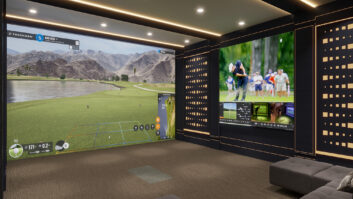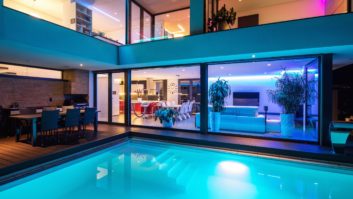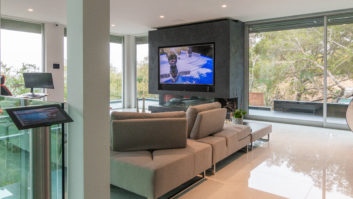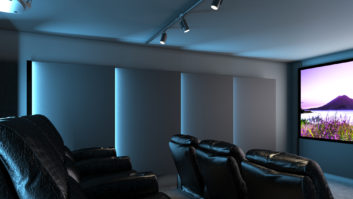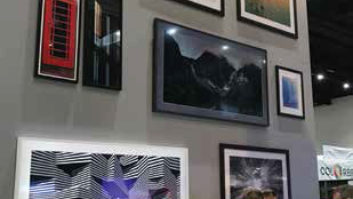The importance of acoustics is commonly understood in the professional recording and sound reinforcement fields, but is really only recently commonly being considered as a factor for residential projects. Yet the difference between sound in an acoustically designed space and a typical untreated room can be night and day.
For commercial projects, it is fairly common for architects to bring in an acoustical consultant, especially for public facilities such as houses of worship, performance spaces, meeting facilities and sometimes even public areas in buildings and restaurants. It only takes the completion of one building where the acoustics impede the function of the space for an architect to get serious about this critical design element.
I am glad to report a recent increase in awareness about the importance of acoustics for private screening rooms and dedicated home theaters. Let’s explore why acoustics are so important to our market. The sound we hear from a sound system, whether from a stereo system or home theater surround sound system, comes to our ears directly from the speakers, as well as from the walls, ceiling and floor. By the time the program material hits our ears, it has become a veritable potpourri of direct sound, reflections, standing waves and room resonances, all at various timing or phase. The only way this could be avoided would be to listen to a single speaker driver in an anechoic chamber (which would sound similar to a closet full of clothes), definitely not what we want for music or entertainment. The best sounding rooms are not dead at all, but rather have a natural sounding mix of reflective and absorptive surfaces.
I have said in several previous articles that I would rather have an average quality pair of speakers in the proper location than a great pair of speakers located poorly. By the same token, I would rather have an average quality set of speakers in a room with good acoustics than a great set of speakers in a bad acoustical environment. Differences in rooms, typically, are greater than the difference between speakers, assuming at least a decent quality level for the speakers.
What to do with all of this? Those of us in the audio/video systems integration industry know that clients rarely are willing to design their homes around speakers and equipment, much less around acoustics. Not only will doing so potentially interfere with architectural and aesthetic priorities, but the costs involved in the proper design and implementation of an acoustically designed space can be significant. There is, however, a great incentive to educate our clients about the importance of an investment and compromise in this area. Not only will the systems we provide sound better, resulting in a happier customer, but also there is an opportunity to make some additional profit at the same time.
Okay, now that our client is interested in an acoustics package, what do we do next? First, consult with an acoustician, someone that is generally a person who holds a degree in engineering and/or physics and specializes in the science and math of sound. This person will analyze the dimensions of the room, review the selected construction materials and finishes, perform the requisite math and then create a design, specific to the room and the intended results. He/she then will make a series of recommendations that might include changing the dimensions of the room (when possible), changes of the selection of construction techniques and/or materials, and the application of a range of acoustical treatment products or materials. For projects with large budgets and/or particularly challenging designs, most acoustics consultants can perform computer “modeling” to simulate room acoustics and how best to tailor them to the specific requirements of the project.
Like the creation of a great meal, the magic of room acoustical treatment is in the recipe. An acoustically designed room will include a calculated combination of hard reflective surfaces, absorptive surfaces, diffusion (reflective surface that breaks up, or reflects sound in many directions) and bass trapping.
Once the acoustical treatment design has been finalized, the next step is to perform the specified construction, procure all of the various acoustical materials and install them in the prescribed locations (it is very important not to improvise here, as it will drastically affect the outcome). Once this is complete, a wall fabric system can be installed to cover the various acoustical materials. Remember, the requirements for the wall fabric system need to be clearly understood and prepared for, before installing anything, or lots of reworking will be required to incorporate the tracks or rails for the fabric.
One way my company approached this subject in the past was to send a copy of the plans to one or more acoustical treatment manufacturers, and ask them to advise us on the application of their products for that room. This approach has worked well, although sometimes their response is a little heavy in the application of their products (as would be expected, considering the source). We generally adjust the recommendations to the specific goals of the client and to their budget, making subtle changes to some of the materials. One thing to consider is that under this approach, we end up being responsible for the final results, so be careful.
There are many companies that offer complete theater “packages” including acoustical design and treatment. Be careful in your analysis of the qualifications and expertise of these designs, as not all of these companies employ trained professionals in this area. Simply listing all the projects and clients who have hired them does not mean that the results were as good as they could have been, even for the budget they had to work with. Some of these companies are primarily in the business of selling seating, wall sconces, curtains, finishes and thematic memorabilia. Try to verify their science and the measurable results before taking the easy way out and just leaving the acoustics to others, especially if part of a turn-key package. Some of these companies will include the design services of a known acoustician, usually upon request, and additional cost. I suggest this would probably be a good investment.
My company is in the process of building a new screening room in our facility to demonstrate our systems to potential clients. We suffered over how best to approach the acoustics for some time, finally choosing to go with ARS (Acoustic Room Systems). Some of the reasons are that they seem to have a good balance of real science, aesthetic finishes and they offer an entire acoustic treatment/wall covering solution as a package, including design. Also, we think their package is the best single-source solution for us to offer to our clients, so we decided to make our screening room a demonstration room for this offering in addition to the projectors, sound systems and control options we will demonstrate there.
The side and rear walls were finished last week, but we have not added treatment to the ceiling yet, nor have we installed the front screen with masking and curtains, nor have we installed the carpet. Even so, we set up a medium-priced two-channel sound system in the room to demonstrate a pair of speakers for a client, and we were all amazed by how good the room sounded and how incredible the room made a $2,000 pair of speakers sound. Money well spent.
David Epstein ([email protected]) is the founder and president of SEi/Sound Solutions, in Santa Monica, California.

